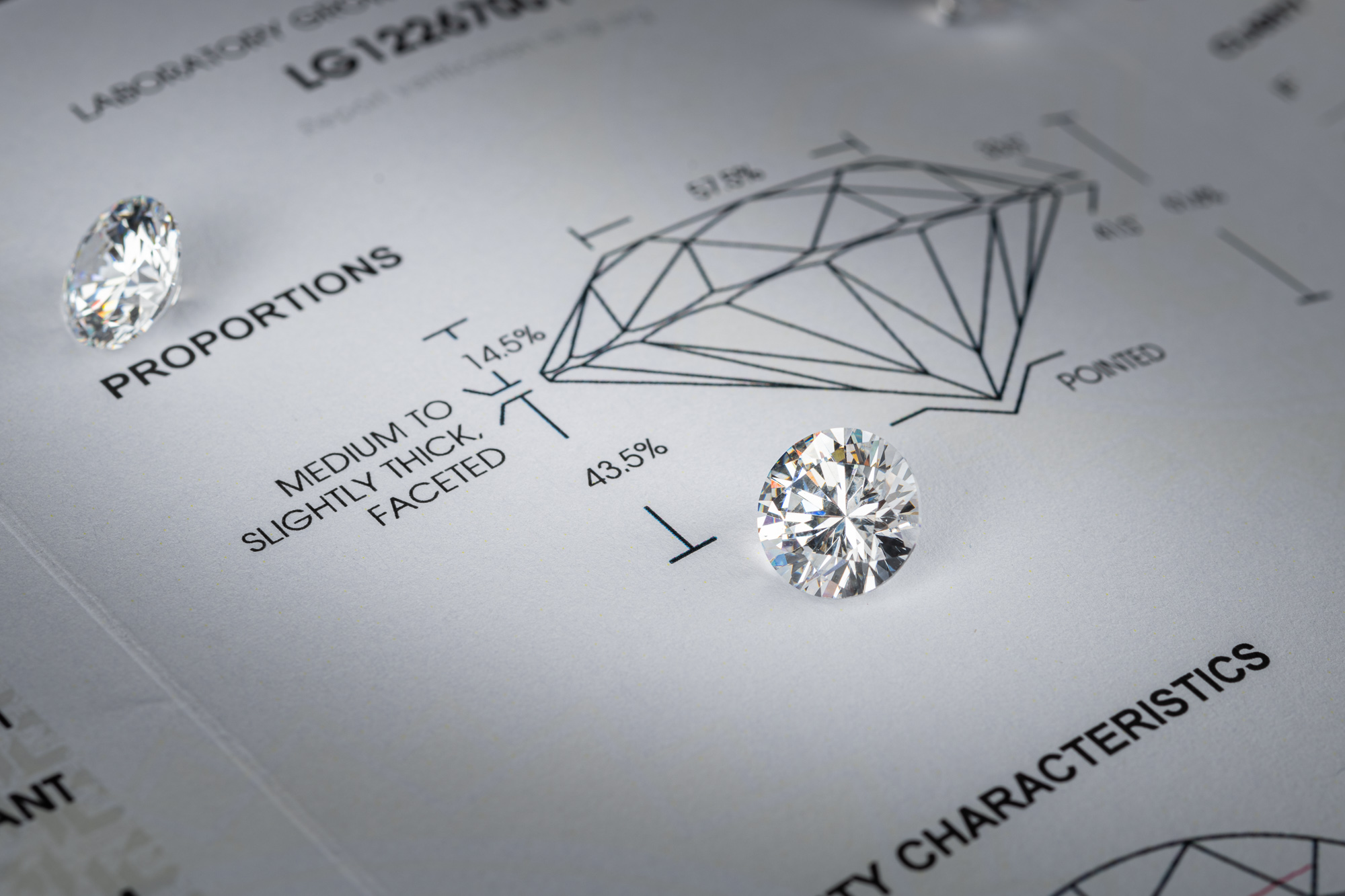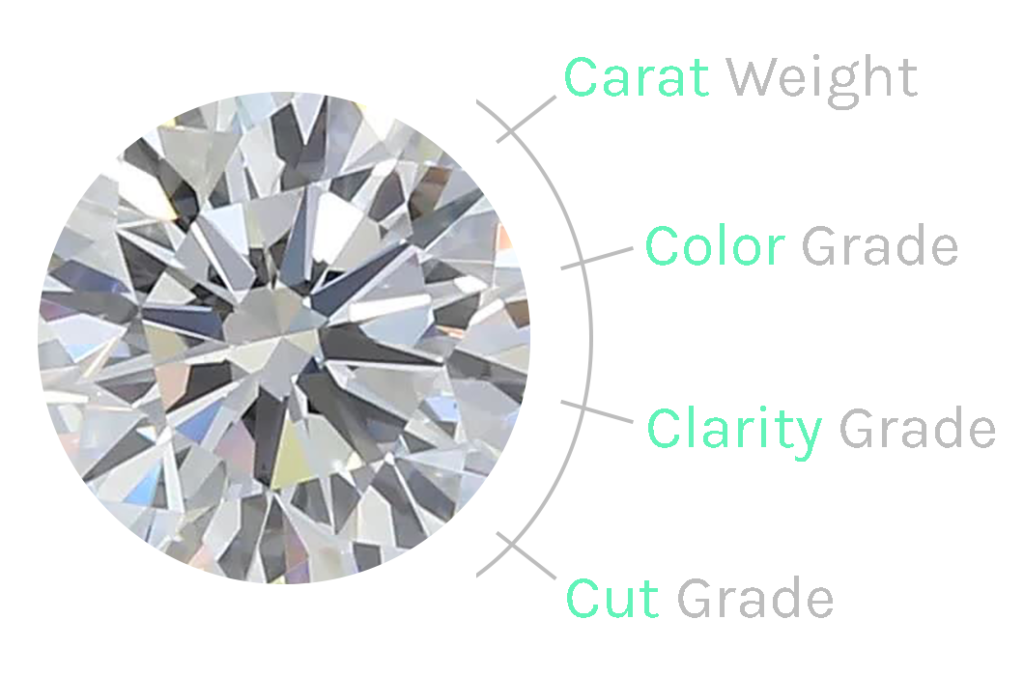
How do I know if a diamond is beautiful and good? How are diamonds evaluated and classified?
BASIC, BASIC KNOWLEDGE: 4 C’s (Carat, Color, Clarity, Cut)
Green World Diamonds, your EXPERT and specialist in Switzerland in Zurich
Even with a certificate and video, it is very difficult for laymen to recognize how good a diamond is and whether its longevity and beauty are negatively affected.
The 4C’s are the base. Even within the purity grades there are large differences (VS2 is not equal to VS2). Not everything can be seen on the certificates! Furthermore, there are extremely many other things to consider e.g. Inclusion Type & Location, Milky, Brown or Blue Shade, Nuance, Blue Tinge, external Characteristics, Inclusions coming to the surface or edge, Girdle etc.
The help of a professional and trust is important when buying diamonds.
QUALITY DIFFERENCES
At Laboratory Grown Diamonds, there is “Low Quality” and “High Quality”.
To assess the quality should have a professional and trusted person who know very well the technology, manufacturing processes and methods, as well as the manufacturing laboratory. Quality differences exist in both white diamonds and fancy color diamonds. Coated diamonds, for example, have only a thin coating of color that fades, scratches, or chips over time.
What are the 4 C’s in diamonds?
Diamonds are analyzed and classified based on the 4 C’s (Carat, Color, Clarity, Cut) and fluorescence.
- IGI, GCAL, GIA etc. Laboratory Grown Diamond Report
→ same IGI, GCAL, GIA, etc. Report/Certificate
with the same info as mine diamonds - Laser engraving with number on the girdle of the diamond
Inscription(s) LABGROWN IGI LG11849219
Thus, the stone is distinctive/non-interchangeable and guaranteed conflict-free & sustainable.
All Green World Diamonds (except the very small diamonds) have a laser engraving with a number (girdle inscription with the report number) you can read this number with a magnifying glass on the diamond girdle (belt) and this is also written on the certificate. This way you can be sure that your stone is the one that has been examined by the independent certification company (gemmological laboratory) and that it is identical with the stone from the certificate.
Color, clarity, cut and carat weight. Today, the 4Cs of diamond quality are the universal method for evaluating the quality of a diamond, anywhere in the world. The creation of the 4Cs for diamonds meant two very important things:
- Diamond quality communicable in universal language
- Buyers can now know exactly what they are buying
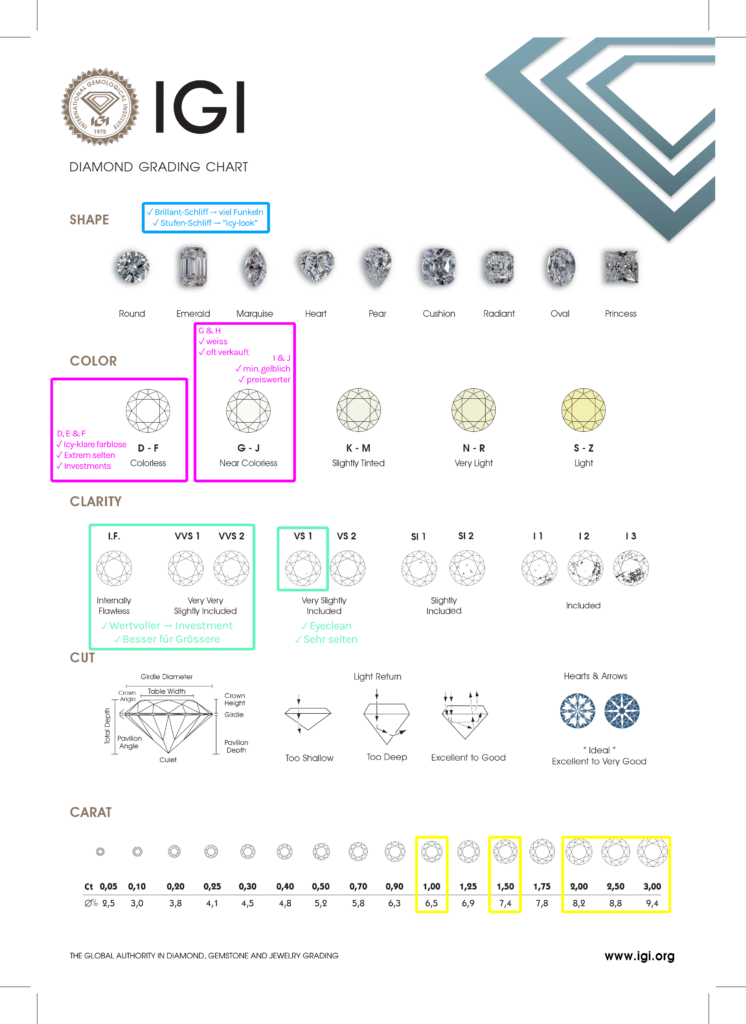
Carat; ct., weight
What is 1 carat for diamonds? How much is a carat? Is carat the same as diamond size?
1 carat (ct.) = 0.2 gram = apparent size of a diamond
…carat is the most striking feature.
Everyone knows it, everyone asks for it first.
Recommendation: “bigger is better”, “size matters”, big is beautiful
“MAGIC SIZES”
- 0.5
- 0.75
- 1 Carat
Visually, there is hardly any difference between a 0.99 carat and 1.00 carat diamond
→ But: usually considerable price difference!
They are called “magic sizes” because the price “magically” jumps once it reaches 1 carat and other large fractions, mainly every 1/4 carat.
Larger gemstones are much rarer than small ones, which makes large diamonds much more valuable. Diamond prices increase exponentially with carat weight.
Thus, a 2-K
Thus, a 2-carat diamond of a certain quality is always worth more than two 1-carat diamonds of the same quality.
I.e. the price per carat (carat price; USD/ct) is usually much higher for a 2-carat than for a 1-carat.
Diamonds with the same weight do not necessarily appear the same size
Diamonds that are cut too shallow or deep → may look small or lose brilliance. For reference, IGI recommends the following vertical diameters for round brilliant diamonds.

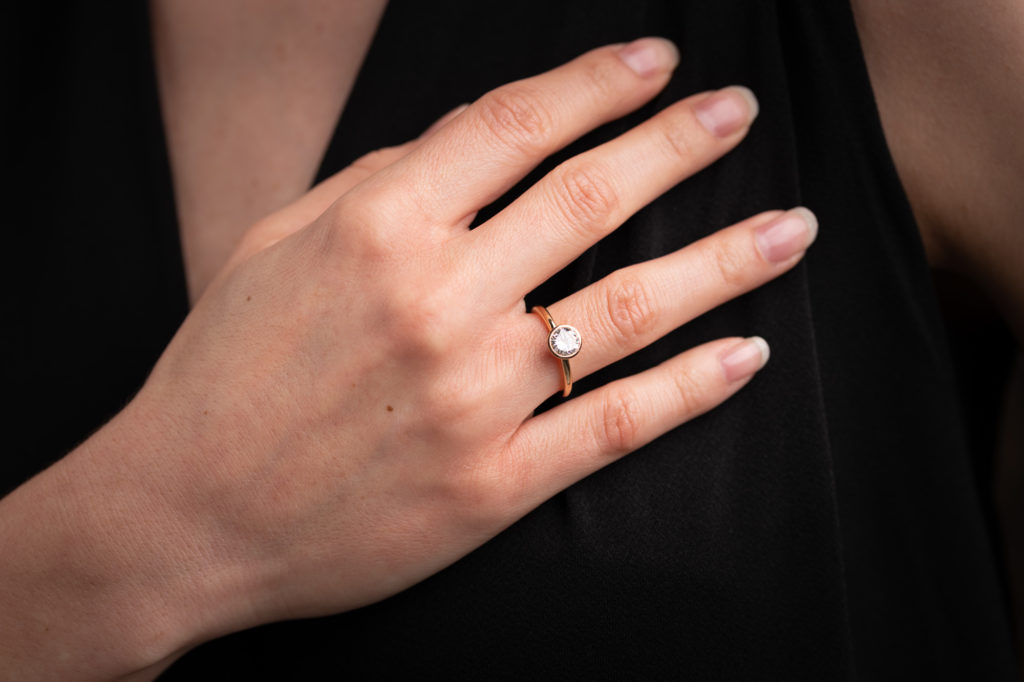
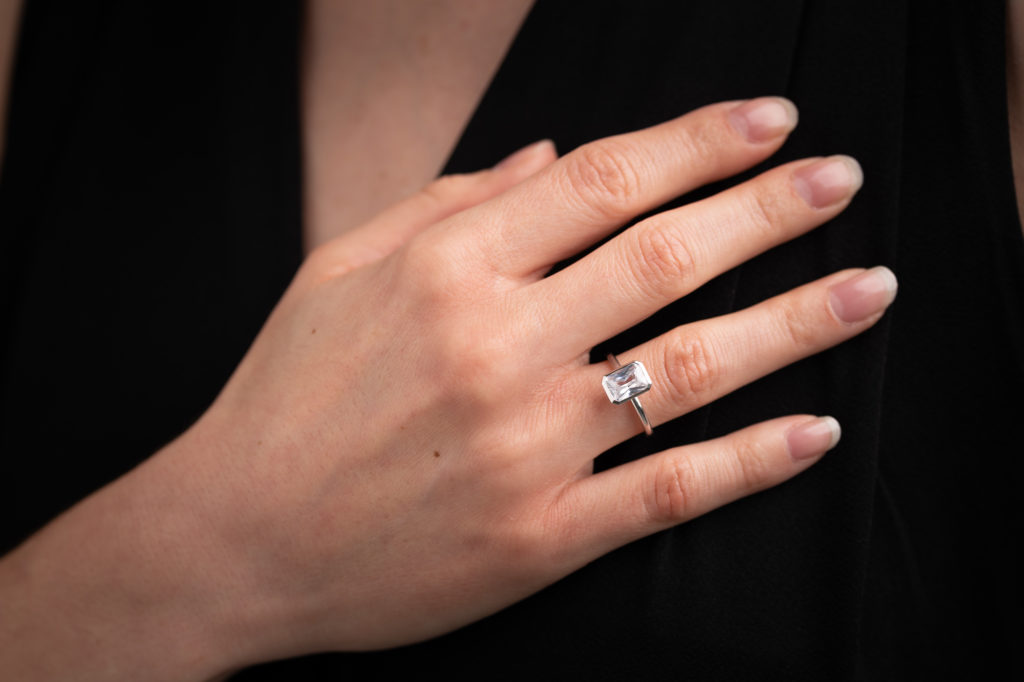
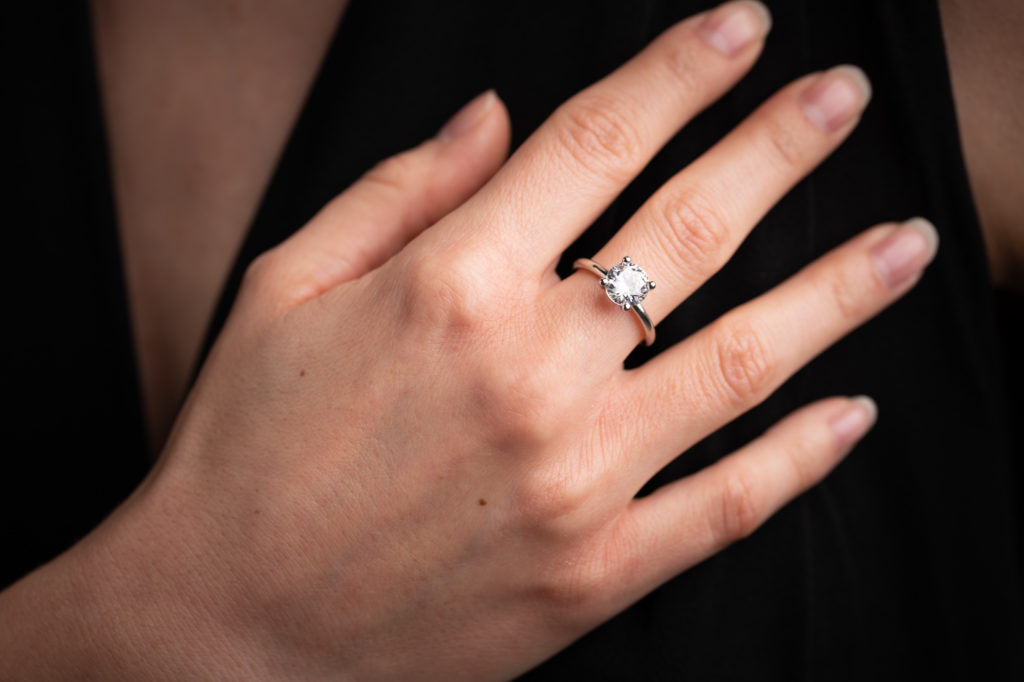
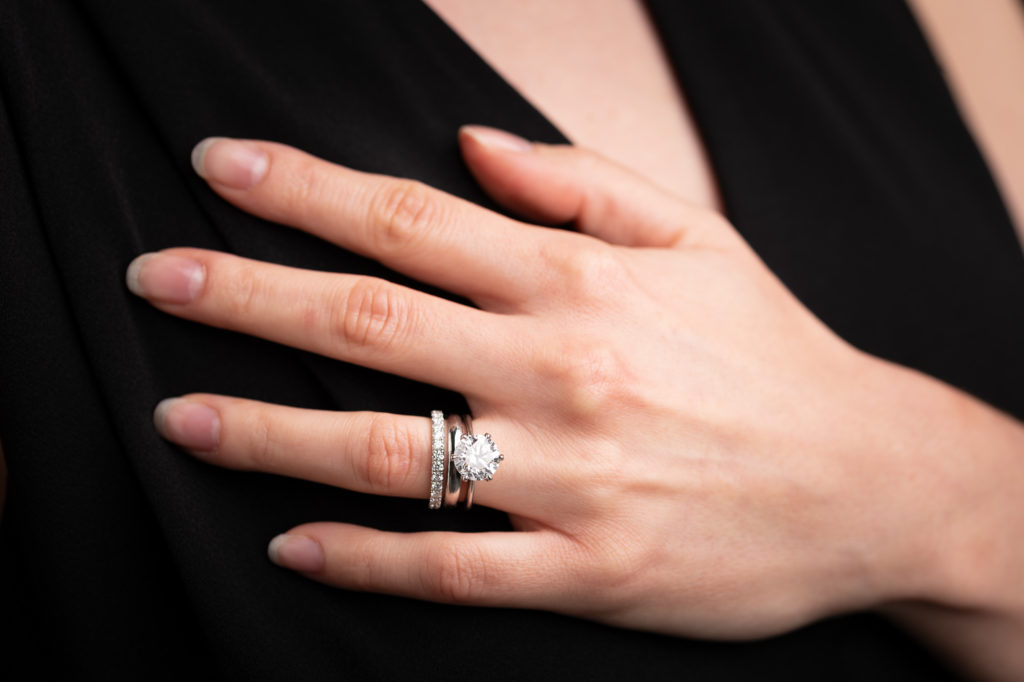
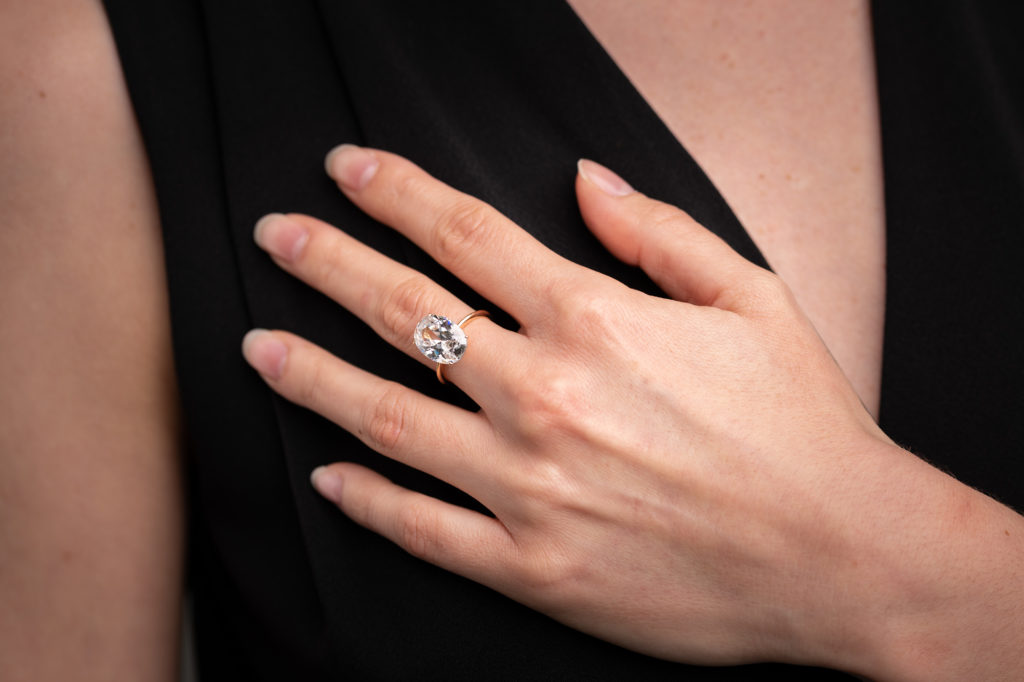
Color – Diamond color
What is the diamond color, Diamond Color? Does the diamond color affect the diamond price?
Color is basically differentiated into white/clear diamonds and fancy color (colored diamonds, e.g. yellow, blue, pink, etc.).
Diamond color is a significant characteristic that affects the visual appearance and value of a white diamond. The color quality of white diamonds is rated on a scale from D (colorless) to Z (slightly tinted). Diamonds in the D to F range are considered colorless and are particularly sought after for their pure and radiant appearance. G-H diamonds show only slight hues that are barely perceptible to the naked eye and are an excellent choice for high quality jewelry. The choice of diamond color depends on personal preference, budget and the desired appearance of the piece of jewelry. Careful consultation and knowledge of individual preferences are crucial to selecting the perfect white diamond for a unique and radiant piece of jewelry.
Note: over 80% of H Color Lab Grown diamonds are brownish which negatively affects the brilliance and makes them appear dark. Some G Colors are also brownish. It must be a nice H or G!

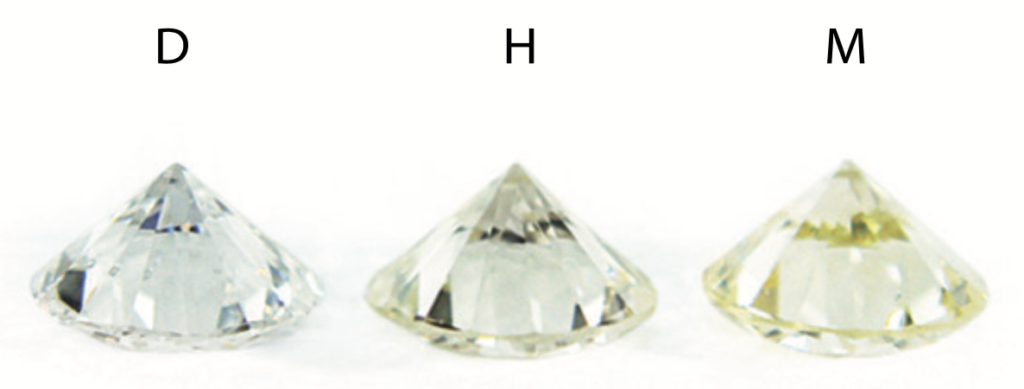
✓ D, E & F: colorless
- Icy clear colorless diamonds
- White – colorless – “highest color levels
…can appear silvery-bluish depending on the incidence of light…
- Extremely rare (most expensive)
- Preferred for investments
✓ G & H: near colorless, upper range of the scale
- White “near colorless” diamonds
- Super quality
- Gladly/much sold at global top luxury brands
- Cheap
- Beautiful with rose & yellow gold
- Note: over 80% of H Color Lab Grown diamonds are brownish which negatively affects the brilliance and makes them appear dark. Some G Colors are also brownish. It must be a nice H or G!
✓ I & J: near colorless
- “sunkissed”
- Barely visible warmer, minimally yellowish tint (white)
- Beautiful with rose & yellow gold
- Cheap
- Rare at Lab Grown Diamonds, as all producers strive to produce top colors
✓ K to Z: slightly tinted to light (= warmer, slightly yellowish tones)
- “sunkissed”
- Minim yellowish tinted color “slightly tinted” (yellow-white)
- Beautiful with rose & yellow gold
- Cheap
- Rare at Lab Grown Diamonds, as all producers strive to produce top colors
IGI color determination
→ All diamonds submitted are compared with an internationally recognised master set of stones
→ For color determination, diamonds are viewed face down and through the pavilion.
The reason for this is that Size, shape, cut quality and the presence of fluorescence can affect the visible face-up color. In fact, lighting, choice of fixture, and even the clothes you wear all have an impact on color, so IGI uses the most neutral environment possible to ensure accurate and consistent results.
The “Old Terms” & “Scandinavian Terms” Color Grade
Another color grade color scale for diamonds is the so-called “Old Terms” – also known as the yellow series – which was introduced in the USA at the beginning of the 20th century. The different color grades were given their names in reference to the places of origin of the diamonds colored in this way. Terms like Top Wesselton (TW) are rarely used today, for example in Scandinavia.
| IGI, GCAL, GIA | CIBJO – IDC | Scandinavian Standard | |
| Colorless | D | Exceptional White + | River |
| E | Exceptional White | ||
| F | Rare White + | Top Wesselton | |
| Near Colorless |
G | Rare White | |
| H | White | Wesselton | |
| I | Slightly Tinted White |
Top Crystal | |
| J | Crystal | ||
| Faint Yellow | K | Tinted White | Top Cape |
| L | |||
| M | Tinted Color | Cape | |
| Very Light Yellow | N | ||
| O | Light Yellow | ||
| P | |||
| Q | |||
| R | |||
| Light Yellow |
S | Yellow | |
Differentiation from Yellow Fancy Color
What is a Fancy Color Diamond? What are colored diamonds?
IGI Colored Diamond Report: Diamonds with more color than Z = Fancy Yellow
The distinction between “white diamonds” and “yellow fancy color diamonds” starts after the color “Z” on the white diamond scale. Diamonds with more yellow than “Z” are considered “Fancy Color Diamonds”.
= other shades like blue, pink, orange, etc.
Clarity (Purity, Inclusions & Blemishes)

What is the diamond clarity? Does the diamond clarity influence the diamond price?
Recommendation: Min. “VS” & “eyeclean”
When is a diamond “eyeclean”?
There is no general rule or specific clarity grade that guarantees an eye-clean diamond. For example, a VS2 is not necessarily eye clean, but in many cases it is.
Attention: eyeclean, eyeclean is not equal to flawless!
2 purity characteristic species:
- “Inclusions” = internal features → enclosed in the diamond. In the IGI certificate: marked in red
- “Beauty flaw” = external features. In the IGI certificate: marked in green
I.F. Internally Flawless (I.F.)
- No defects visible under 10x magnification
- No inclusions visible under 10x magnification
- Loupe Clean at 10x magnification = Loupe Clean (LC)
VVS1 & VVS2 Very Very Slightly Included
- Valuable
The freer from inclusions (better clarity), the more valuable the diamond is. - Investment
Investments → Diamonds of top qualities are preferred as investments - better for large diamonds
The larger the diamond, the more likely you are to see inclusions - Minimal inclusions, at 10x magnification
very difficult to detect for an experienced grader
VS1 & VS2 Very Slightly Included
- “Eyeclean” idR. VS1
Inclusions are observed with difficulty under 10x magnification
but can be characterized as minor
SI1 & SI2 Slightly Included
- Inclusions are conspicuous under 10x magnification
- SI1: Small inclusions, easily visible at 10x magnification, usually invisible to the naked eye from the crown
I1, I2 and I3 Included
- Inclusions are obvious at 10x magnification
- Transparency and brilliance may be impaired
Exactly the same as with mine diamonds there are Lab Grown diamonds also have “inclusions” when they are created in the lab.
Diamonds = result of carbon being subjected to tremendous heat and pressure.
This process can lead to a variety of features.
Natural conditions are imitated in the cultivation of rennet diamonds
HPHT = ✓ analogous conditions deep earth interior
CVD = ✓ analogous conditions interstellar gas clouds
During this “growing process” the exact same inclusions can occur as with mine diamonds.
The Inclusions types of rennet diamonds are also found in mine diamonds. So they are not different/different types of inclusions. Only: a few mine diamonds have so-called “natural inclusions”. Analogous to a mosquito in an amber. Such inclusions do not occur in lab diamonds in the “clean” lab environment.
Lab diamonds often have better color & clarity & hardness than mine diamonds.
Still, Lab diamonds often even a better color and purity (= quality). Partly Lab diamonds are even harder than mine diamonds because of a better “compression”.
We also have the impression that with lab diamonds from the best laboratories with excellent quality, the inclusions are often very local and the “rest” of the diamond is crystal clear, whereas with mine diamonds, small inclusions can often be observed throughout.
Inclusion Assessment:
- Size
The larger or more conspicuous a feature is, the lower the likely clarity level is
- Number
Number of easily recognizable characteristics → less conspicuous characteristics mean a higher degree of purity
- Position
→ under the table (most visible) and near a pavilion → inclusions become reflectors, which have a greater influence on the degree of purity
- Species/Nature
Type of inclusion and its influence on the shelf life
- Color and relief
Color and relief are essentially a measure of how easy a feature is to see, or how great the contrast is between the feature and the surrounding diamond
There are many different types of diamond inclusions and beauty flaws e.g.
Types of Diamond Inclusions
- Clouds
- Feathers
- Needle
- Pinpoints
- Twinning Wisps
- Crystals or minerals
- Knots
- Cavities
- Cleavage
- Internal graining
Types of Blemish
- Polish lines
- Bearding
- Scratches
- Nick’s
- Pits
- Chips
- Breaks
- Dark or light spots
Small crystals can be trapped inside a diamond as it forms. As a crystal grows, it can sometimes develop irregularities in its atomic structure. The size, position and visibility of inclusions can have a significant impact on the clarity of a diamond.
Remember that no diamond is perfectly pure. But the closer he gets to purity, the better his clarity.
Cut

Is the cut important in a diamond? Does the diamond cut have an impact on the price?
Recommendation: “ideal” & “excellent” (for round white diamonds),
Min. “very good”
The cut is the most important criterion, more important than polish & symmetry!
Poorly cut diamonds can appear lackluster.
Cut directly contributes to the appearance of a diamond because it describes:
- Brightness (brilliance, brightness)
- Fire (Fire, Dispersion)
- Scintillation (sparkle, glitter)
| IGI Cut Grades | GIA Cut Grades |
|---|---|
| Ideal | / |
| Excellent | Excellent |
| Very Good | Very Good |
| Good | Good |
| Fair | Fair |
| Poor | Poor |
IMPORTANT: IGI’s “Ideal” = better than GIA Excellent.
Whereas both ideal & excellent are really excellent.
When a gemological lab such as IGI, GCAL, GIA, etc. evaluates a round diamond for cut quality, they assess the proportions of the diamond and visually examine the diamond for fire, brilliance and sparkle (contrast patterning).
Brightness (brilliance, brightness)
- All light returning to the eye
- Internal and external white light reflected from a diamond
- Combination of white light reflections from the inner and outer surface of the diamond
Fire (Fire, Dispersion)
- Scattering of white light into all rainbow colors
- The way light is refracted into different colors of the spectrum (spectral colors).
- It is typically seen as rainbow-colored flashes of light and is predominantly found in the crown facet area
Scintillation (sparkle, glitter)
- Amount of sparkle produced by a diamond
- Pattern of light and dark areas caused by reflections in the diamond
- Contrast patterns (contrasting light and dark areas created by the reflection of the viewer)
- You can see how the diamond, the light source or the viewer moves
- Sparkle that a diamond shows when moved or tilted at an angle to the eye (light and dark shades).
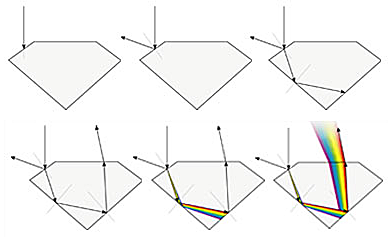
Image courtesy of IGI “Courtesy of International Gemological Institute”
External refraction is when a beam of light touches the surface, part of it is reflected back
Refraction is the rest of the beam penetrates the stone and moves through it
Dispersion is when the part of the beam reflected back to the surface emerges broken down into spectral colors in a prism-like effect.
All these elements contribute to the appearance of a diamond.
These qualities combine to give the life of the diamond and the way it reacts to light and the environment. The planning, the proportions, the precision of the cut and the details of the execution determine how brilliant, dispersive and sparkling the diamond will be. If the human-controlled cutting factors are not optimized, the appearance of the diamond can be adversely affected.
Diamond faceting has changed over time, especially with the evolution of lighting. There are many shapes and cuts, each with different visual characteristics. The most popular diamond in the age of modern electric lighting is the round brilliant.
Diamonds are known for their ability to transmit light and sparkle so intensely. We often think of a diamond’s cut as a shape (Round, Heart, Oval, Marquise, Pear), but which diamond cut is actually cut means how well a diamond’s facets interact with light. Shaping a stone so that its proportions, symmetry and cut allow the magnificent return of light that is only possible in a diamond requires precise artistry and workmanship.
Getting the best cut for a diamond is reflected in the final beauty and value of the stone. Of all the 4C’s, cut/grind is the most complex and technically the most difficult to analyze. To determine the cut grade of the standard round diamond – the shape that dominates the majority of diamond jewelry – GIA calculates the proportions of those facets that affect the appearance of the diamond from above. Using these proportions, GIA can assess what the best cut is for a diamond by examining how successfully a diamond interacts with light to create desirable visual effects.
Triple Ex (3 Ex)
3 times Excellent/Ideal in Cut & Polish & Symmetry = “Triple Ex” (3 Ex)
What is a Triple Ex Diamond? What is a 3EX diamond?
Especially for round diamonds, the expression “3 times Excellent = Triple Ex (3 Ex)” is a technical term for absolute top class → three times the very best category (Ideal or Excellent) for cut, polish, symmetry.
“Triple Ex” are diamonds that are graded excellent in both Cut, Polish and Symmetry in the diamond certificate → 3 times excellent.
Since IGI “ideal” cut grade is even slightly better than excellent, “Triple Ex” of course also applies when a diamond has an ideal cut (although the wording is not 3x excellent).
IMPORTANT: IGI’s “Ideal” = better than GIA Excellent! (though both cuts are excellent).
IGI has an additional level for Best-of-Best of Excellent = ideal.
This sometimes causes confusion, as people think it must be 3x Ex, but ideal is even better.
Triple Ex stones are classified as follows:
| Ideal (better) or excellent | Cut |
| Excellent | Polish |
| Excellent | Symmetry |
Symmetry & Polish
Recommendation technical literature = “good” = completely sufficient
Differences from “Very good” to “Excellent” hardly noticeable
“Cut” more important than Symmetry & Polish
Polish and symmetry have little effect on performance, a “good” is quite sufficient.
→ much smaller effect on the brilliance and fire of the diamond than the cut with cut proportions such as table% and depth%.
Symmetry, Symmetry
What is the diamond symmetry?
Symmetry is the exactness of the shape, overall outline, placement and alignment of the individual facets.
Symmetry is how well the facets of the diamond are aligned.
NOT as many people believe: shape of the stone
→ Are facet edges on the top and bottom of the diamond aligned along the girdle?
→ Are the facets symmetrically aligned around the diamond?
Poor symmetry = “Fair” & “Poor”
You will only see noticeable symmetry defects in diamonds with “Fair” or “Poor” symmetry grades.
→ visible deviation from shape
→ Reduction of brilliance due to misdirected light transmission
Is the symmetry of a diamond more important than the polish?
The simple answer to this question is: not really.
If a diamond has asymmetrical features, such as an off-center table or misshapen facets, this can affect how well light reflects off the diamond.
Recommendation Symmetry: “Good” = completely sufficient
Differences to “Excellent” at Symmetry & Polish hardly recognizable even by experts
“Good” → Diamond is not negatively affected
Symmetry is more important in very pure diamonds of VVS2 or higher.
Symmetry is more important in diamonds with a clarity of VVS2 and higher, as the very subtle variations that result from moderate or poor symmetry (which can resemble pinpoint inclusions) would detract from the otherwise flawless appearance of the diamond.
Symmetry → Light Reflection & Brilliance
Symmetry affects how well a diamond interacts with light and how brilliant a diamond is. A diamond with good symmetry allows light to travel through the diamond as it should. The light is reflected back from the facets and angles and passes through the panel to your eyes.
A diamond with poor symmetry will send light through at faulty angles, meaning that light may leak through the bottom or sides of the diamond. If the light is not reflected back to the eye, the diamond looks dull. For this reason, symmetry is crucial to the beauty of a diamond.
Rating Symmetry
The degrees of symmetry are classified by the GIA as Excellent, Very good, Good, Fair and Poor. The degree of symmetry is based on the visibility and presence of deviations at 10x magnification (a standard jeweler’s loupe). Several issues come into play when evaluating a diamond for symmetry, including misalignment, missing facets, extra facets, and an off-center table.
GIA degrees of symmetry
Excellent
= very few, if any, deviations
Panels are centered and have no additional or missing facets
Very good
= a few slight deviations
e.g. slight misalignment or an incorrectly shaped facet
Good
= a few deviations
Brilliance could be affected by aspects e.g. pavilion angle deviation or missing facet.
Fair
= several deviations
Brilliance of the diamond is affected by misalignments, variations and flaws.
Poor
= several obvious deviations
The diamond probably looks dull. It could have a combination of an off-center panel, missing facets, variations, and misshaped facets.
Symmetry error
Extra facet
One inclusion is ground off and resulted in an extra facet → this is penalized by GIA.
It is a major misconception that the presence of symmetry defects indicates poor grinding capabilities. That’s not true.
In fact, most decisions made during the grinding process are carefully planned and “real” mistakes are extremely rare. The main goal a cutter wants to achieve when polishing a rough diamond is to get the maximum value out of the rough diamond.
Often, the decision to polish a rough stone focuses on maintaining the carat weight and compromises the cut quality. Cutters may intentionally create facets that do not meet exactly to achieve “magic weights” such as 1.00 carat or to remove inclusions from the final product.
The reason is that a diamond with “good” symmetry (at 1 carat weight) is more marketable and valuable than a diamond with “excellent” symmetry (at 0.96 carat weight). It’s sad that cut quality is usually the first aspect to be sacrificed, but that’s how economics works in real life.
Sometimes an extra facet or a mis-shaped facet is intentionally used to remove an inclusion and improve the clarity grade of the diamond. This is a calculated move, as the symmetry error does not affect the value as much as the improvement in purity.
A change in symmetry that affects the alignment and balance of a diamond’s facet structure is considered a proportion error. These flaws are usually measurable and affect the overall appearance of the diamond.
Examples of proportion errors
- Out of round girdle outline (Out of round girdle outline)
The diamond does not appear round and may have angled areas
- Off-center table
The panel facet does not appear centered in the crown view
- Off-centre culet (off-centre culet)
In the top view, the point where the main facets of the pavilion meet is not correctly centered
- Table/culet alignment (Table/culet alignment)
Table and dome are positioned incorrectly
- Pavilion angle variation (Pavilion angle variation)
Significant variation of the 8 measured pavilion angles
- Crown angle variation
Significant deviation of the 8 measured crown angles
- Wavy belt (Wavy girdle)
Instead of being uniform, the belt takes on an undulating appearance
- Girdle thickness variation (Girdle thickness variation)
Variations in the roundel thickness around the edge of the diamond
Examples of facet errors
On the other hand, facet-related errors focus on the regularity of each facet. Basically, similar facets should all be cut to the same size and regularity (i.e. all bezel facets should look the same, all pavilion main facets should look the same, etc….).
- Missing/Extra facets
Are usually attached or removed without regard to symmetry to remove inclusions
- Unshaped facets (Misshapen facets)
Uneven shape and size of the facets
- Truncated facets (Truncated facets)
The tips of the facets do not end correctly at the belt
- Not a regular octagon (Table not a regular octagon)
Unequal 8-sided table facet
- Not pointed (Non-pointing)
Facets do not meet at a single point at the junctions - Incorrect alignment of crown and pavilion facets
Incorrect placement of the lunette and pavilion main lines.
Strong displacements usually lead to the formation of an undulating belt.
Polish, polish
What is the diamond polish?
Polish is the quality, smoothness and condition of the facet surfaces
Poorly polished diamonds (Fair & Poor) can look dull
When the facets – which act like small mirrors – are clear and smooth, they reflect the light well. A well-polished diamond can produce sharp reflections and undistorted light transmission. If the facets of a diamond are not smooth, they can inhibit or alter the reflection of light → diamond appears dull.
A rough diamond often has tiny crystal bumps on the facets. When a diamond is polished, these imperfections are removed. By using fine-grained diamond dust on a polishing wheel and polishing for a long time, a gemologist achieves higher degrees of polishing.
Recommendation Polish: “Good” = completely sufficient
So that your eye cannot see any polishing defects (only visible through a jeweler’s loupe) you should choose polish “good” or better. Differences “excellent”, “very good” and “good” at Polish are difficult to recognize even by experts.
Itis important that polishing features do not penetrate the surface of the diamond.
Does diamond polish matter?
Diamond polish affects the beauty and brilliance of a diamond, but not as much as you might think.
Technically, “Excellent” polished diamonds have been ground longer on the polishing wheel with a finer grit of diamond dust. But the differences are not/difficult to see with a 10x loupe.
Diamond polishing grades are assigned based on the smoothness of each facet. A gemologist inspects the diamond under magnification to determine the degree of polish.
It is rare for a diamond to have a perfect polish. More often, they have tiny imperfections that are not visible to the naked eye. These can be pits, abrasions, nicks, scratches and burn marks.
GIA polishing grades
Excellent
No polishing defects are visible under 10x magnification (standard jeweler’s loupe).
Almost every diamond (except flawless stones) has some remnants of polishing marks on its surface. In a diamond with an “excellent” polish rating, the polish lines are so fine that they can only be seen under high magnification and at a certain angle of inclination.
Very good
Polishing defects are very difficult to detect under 10x magnification.
Good
Polishing defects are somewhat difficult to find under 10x magnification.
Fair
Some polishing defects can be seen under 10x magnification and may also be visible to the naked eye.
These diamonds are not recommended.
Poor
Defects are visible under magnification and to the naked eye.
These diamonds are not recommended.
Polishing features
Many factors play a role in the polishing grade and quality of a diamond. Most diamonds have some tiny polishing features on its facets. These tiny blemishes are of different nature and color.
GIA polishing grade characteristics
- Notch: Tiny notch on a roundel joint or facet
- Scratch: Transparent looking line on the surface of the diamond
- Indentation: Small indentation usually caused by a tiny inclusion that fell out of the pocket during polishing.
- Abrasion: Small notches located close to each other in the vicinity of facet functions
- Polishing line: Barely visible fine line that is translucent or white in color
- Burn mark: White haze caused by high temperatures from the polishing wheel or jeweler’s torch.
- Lizard skin: Uneven texture on the surface or facets of a diamond.
- Rough round ledge: An unpolished round ledge
Fluorescence

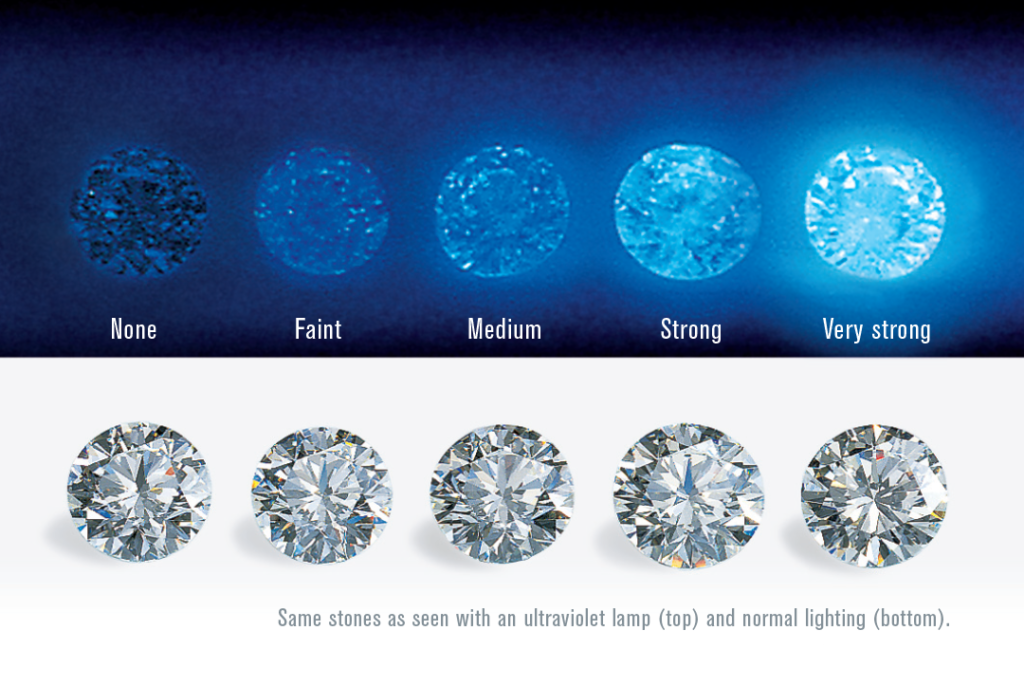
Fancy Color Diamonds
Fancy “Pink”
→ Fluorescence is very common and affects the beauty idR. not
White diamonds
Recommendation: “none”/no to “faint” fluorescence
- → IdR. lower price
- Approx. 10% of stones Appearance negatively affected (from “medium”)
- Approx. 0.2% of the stones cloudy, milky, oily
- → Can lead to a “better” (blue fluorescence) “worse” (yellow fluorescence) color grade
- → Most common fluorescent color = 1. blue 2. yellow 3. further
However, florescence is also a personal taste, tends to be popular:
- → Europe & USA without to little fluorescence
- Asia & Middle East medium to strong fluorescence
The cause of fluorescence are variations in the atomic structure
e.g. the number of nitrogen atoms present
- → Approx. 25% to 35% of mining/mining diamonds.
- → Lab diamonds can also have fluorescence
Fluorescence Grading Report
What is the diamond fluorescence?
= Visible light emitted by some diamonds when exposed to invisible ultraviolet (UV) rays.
- → Strength/intensity of the reaction of the diamond to long-wave UV light (= essential daylight component)
- → Irradiated light lasts as long as the diamond is exposed to the UV source.
Fluorescent color
- Blue = > 95%
…most popular → may get better color grade (white diamonds), because “yellow tinted” can be neutralized with blue
- Yellow = second most common
→ possibly receives worse color grades (white diamonds), because yellow emphasizes the “yellow tinted”. This diamond looks a little better indoors without UV light.
- Orange-Yellow, Orange, Red, White and Green
- Green, magenta and red (rare)
…very strong fluorescence in these colors → diamond can appear darker
Same structural integrity as non-fluorescent diamonds
Submicroscopic substitutions and/or shifts in the diamond structure can both cause and prevent fluorescence.
→ Nothing in either case inherently weakens the diamond or is bad for it
Price effect?
Fluorescent diamonds are usually less expensive compared to diamonds without fluorescence.
Jewelry experts disagree on whether fluorescence increases or decreases the value of a diamond. 2 expert opinions:
- Diamonds with “good” colors with extremely strong fluorescence
→ less valuable than non-fluorescents because fluorescence can affect their transparency
cloudy or milky - Conversely, some dealers pay higher prices for blue-fluorescent diamonds of a lower color because they believe that fluorescence masks the “yellow tinted” color of these diamonds.
Fluorescence has little to no effect on sparkle and beauty
The sparkle of a diamond is primarily determined by its cut, not by whether or not the diamond fluoresces. The cut of a diamond – that is, the angles and relative dimensions of its facets, as well as its other proportions, design, and craftsmanship – determines how well light strikes the diamond and how well it sparkles.
Diamond fluorescence and its effect on value is not a simple question, and there is no simple answer. Ultimately, GIA believes that the beauty of a diamond is truly in the eye of the beholder.
Hearts and Arrows
What are Hearts and Arrows diamonds?
Do Hearts and Arrows occur exclusively in round diamond brilliants? Yes!
In 1996, the IGI created the “Hearts & Arrows Diamond Report”, making it one of the first laboratories to carry out an optical symmetry evaluation.
Many think that the diamond cut marketed as “Hearts and Arrows” must have an Excellent cut. In fact, this cut only indicates perfect symmetry. A “Hearts and Arrows” diamond shows an arrow pattern through the panel and a heart pattern through the pavilion. It will always have excellent symmetry. However, he will not always be excellent in other aspects of the cut.
This Rond Brilliant, round diamond cut has become so popular that “Hearts and Arrows” diamonds usually cost more than comparable diamonds with other cuts, especially when purchased from companies that specialize in this cut. Highly symmetrical diamonds require more time to cut and waste more rough weight than other diamonds. This contributes to their price premium.

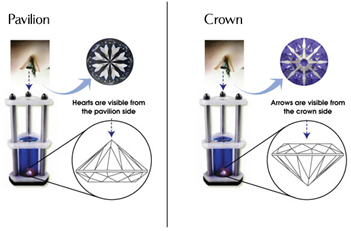
Photo’s with permission of IGI “Courtesy of International Gemological Institute”.
Many other factors to consider when buying diamonds
Besides the 4 C’s, symmetry, polish, fluorescence, there are many other factors to consider when buying diamonds!
